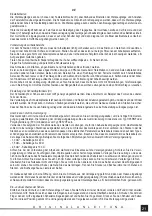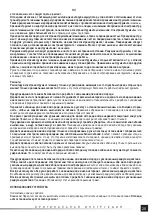
16
EN
O R I G I N A L I N S T R U C T I O N S
have rubber insulation of at least the H05RNF type or polyvinyl (PVC) insulation of at least the H05VVF type.
Always use cords intended for outdoor use due to the nature of the machine work. The power cord should have a single socket
matching the machine’s plug. It is forbidden to modify the plug or socket to make them
fi
t. The electrical parameters of the power
supply cord should correspond to the electrical parameters of the tool, listed on the rating plate. It should be noted that the power
cord’s cross-section depends on the length of the cord. Follow the instructions below regarding the power cord cross-section:
- 1.0 mm
2
– cord length not greater than 40 m;
- 1.5 mm
2
– cord length not greater than 60 m;
- 2.5 mm
2
– cord length not greater than 100 m.
When preparing for operation and during operation, pay attention to the power cord. Protect the power cord from water, moisture,
oils, heat sources and sharp objects. Lay the cord so that it does not come within the reach of the cutting element. Cutting the
cord may result in electric shock and serious injury or death. Make sure that you do not become entangled in the cord. This can
lead to a fall and serious injury.
Do not overload the power cord, and do not cause any of the cord’s section to become tensioned. Do not pull the cord when
moving the tool. Always disconnect the power cord plug from the socket by pulling by the plug and socket housing, never pull by
the cord.
There is an opening in the housing to route the extension cord loop through, and then attach the loop to the hook. Only then,
connect the plug to the socket of the extension cord (VII). This will minimise the risk of pulling the power cord from the machine
housing, e.g. in the event of a sudden jerk.
Starting and stopping the trimmer
Remove the guard from the shear blades. Grasp the trimmer with both hands by the front handle with one hand and the rear
handle with the other. Ensure that the blades do not come into contact with any object or surface. Slide and hold the switch lock
button on the handle with your
fi
nger. Press and hold the power switch in this position. The lock button can be released (VIII). The
tool will be launched.
Wait until the motor has reached full speed and ensure that the blades are running smoothly before cutting. If you hear suspicious
sounds or vibration, turn the trimmer o
ff
immediately by releasing the power switch.
The trimmer is turned o
ff
by releasing the power switch. Unplug the trimmer from mains and proceed with maintenance once the
blade has stopped. The switch does not have a lock to secure it in the “ON” position.
Working with the trimmer
Do not allow the device to operate at low speed or during start-up.
The most e
ff
ective work is if the cutting is done in full wide movements. For greater e
ffi
ciency, the blades can be tilted at an angle
of 5-10° in the cutting direction (IX).
To achieve an even single hedge height, you can use
fi
shing line stretched along the cutting line. Cut the part of the hedge above
the line.
Vertical cutting of the hedge is possible. It is advisable to cut in a curved motion from bottom to top and then from top to bottom
to use both sides of the blades (X).
Working tips
Maintain balance and proper posture during work. Exercise particular caution when working on a slippery, inclined, or uneven
surface.
Constantly keep an eye on the blades during operation. Do not mow in places which are out of sight.
Before starting work, inspect the workplace thoroughly, remove all loose branches and residues from the previous mowing.
Special care should be taken when treating tall hedges. The other side of the hedge should also be checked before starting work.
The trimmer gear cover heats up during operation. To avoid burns, avoid contact with the gearbox cover.
Take regular breaks when working. During operation, the tool emits noise and vibration, which impact the tool’s operator. Taking
regular breaks and wearing personal protective equipment such as gloves, hearing protectors and eye protection allows to reduce
the impact of the tool on the operator’s well-being.
Start work when healthy and in good shape. In case of nausea, headache, sight problems (e.g., reduced visual range), hearing
problems, or dizziness, immediately stop operating the tool.
If the trimmer jams during operation switch it o
ff
immediately using the on/o
ff
switch and unplug the power cord from the mains,
wait until the shear components have cooled completely and then proceed to remove the cause of the jam.
If, due to jamming, any part of the blades or cover is damaged or deformed, replace or repair it before resuming work.
PRODUCT MAINTENANCE AND STORAGE
Caution! Before starting any activities described below, disconnect the trimmer from mains. In the case of mains-powered tools,
disconnect them from the socket, and for battery-powered tools - disconnect their batteries.
After each use, inspect the condition of the tool with particular attention to the patency of ventilation openings.
Check the placement of all of the tool’s components. Tighten all loose screw connections, if any. Check the condition of the blades.
Summary of Contents for YT-84790
Page 24: ...24 RU residual current device RCD...
Page 25: ...25 RU...
Page 26: ...26 RU II III IV V VI H05RNF H05VVF 1 0 2 40 1 5 2 60 2 5 2 100...
Page 27: ...27 RU VII VIII 5 10O IX X...
Page 28: ...28 RU 0 2 0 4 XI...
Page 30: ...30 UA residual current device RCD...
Page 31: ...31 UA II...
Page 32: ...32 UA III IV V VI H05RNF H05VVF 1 0 2 40 1 5 2 60 2 5 2 100 VII...
Page 33: ...33 UA VIII 5 10O IX X 0 2 0 4 XI...
Page 85: ...85 GR RCD RCD...
Page 86: ...86 GR o...
Page 87: ...87 GR II III IV V VI H05RNF PVC H05VVF 1 0 mm2 40 m 1 5 mm2 60 m 2 5 mm2 100 m...
Page 88: ...88 GR VII VIII 5 10O IX...
Page 89: ...89 GR 0 2 0 4 mm XI...
Page 91: ...91 BG RCD RCD...
Page 92: ...92 BG II...
Page 93: ...93 BG III IV V VI H05RNF PVC H05VVF 1 0 mm2 40 m 1 5 mm2 60 m 2 5 mm2 100 m VII...
Page 94: ...94 BG VIII 5 10O IX X 0 2 0 4 mm XI...
Page 95: ...95 BG...
Page 107: ...107 AR RCD DCR...
Page 108: ...108 AR II III IV V VI H RNF H VVF PVC VII VIII...
Page 109: ...109 AR IX X XI...
















































